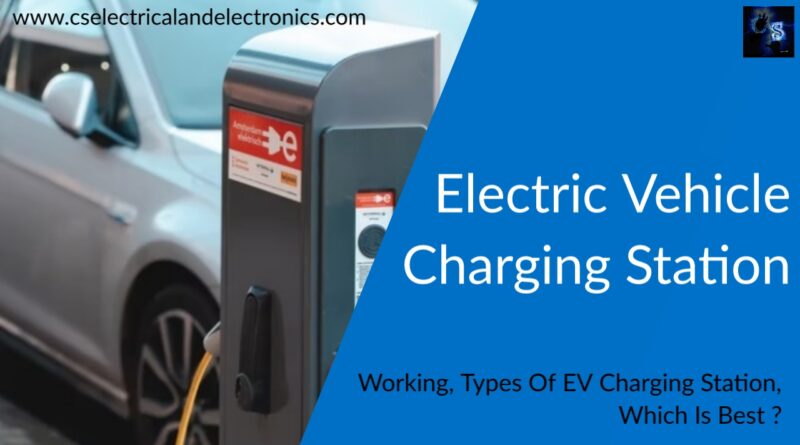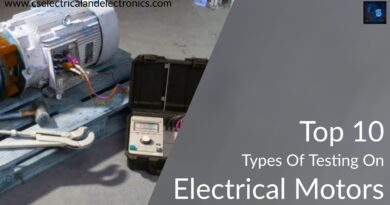Electric Vehicle Charging station, Working, Types Of Charging Stations
Hello guys, welcome back to my blog. In this article, I will discuss the electric vehicle charging station, working, types of charging stations, different ways to charge electric vehicles, etc.
If you have any doubts related to electrical, electronics, and computer science, then ask question. You can also catch me @ Instagram – Chetan Shidling.
Also, read:
- Top 15 Transmission And Distribution Companies In The World
- Types Of Cell Balancing Topologies, Active And Passive Cell Balancing
- Difference Between MCB, MCCB, RCCB, ELCB, Types Of Circuit Breakers
Electric Vehicle Charging station
In 2017, the Indian government pushed a major policy of selling at least 6-7 million EV’s in India by 2023. But many experts in the automobile industry criticized this plan because of the lack of infrastructure and the majority lack of Charging stations. The Indian government is much enthusiastic to push electric vehicles in our ecosystem but people are reluctant to buy an electric vehicle because of the financial crisis.
The electric vehicle charging station is an element in an infrastructure that supplies electrical energy to charge the vehicles such as plug-in electric vehicles, electric cars, etc. The country is in need to provide nationwide a huge network of charging stations for electric vehicles as the government is planning to sell only EV’s by 2030.
Working of electric vehicle charging station
As the EV requires Direct current but the Electricity from the grid is delivered as alternating current. A rectifier is connected between the grid and the battery to convert alternating current to direct current. Superchargers deliver high voltage, high current DC electricity directly to the electro voltaic battery by passing through the onboard rectifier. This allows the supercharger to pass electricity into the EV battery as fast as the battery can take it typically then times faster than home charging.
An electric vehicle operates on an electric motor instead of the engine that generates power by burning a mix of fuel and gases. These electric vehicles reduce emissions and save money.
Solar-powered charging station
These charging stations are powered by solar energy. A number of solar panels are placed on the roof of the charging station. The installed solar panel will deliver limited power to the charging point. Using these solar panels will reduce the load on the power grid and will save a considerable amount of fossil fuel used.
Advantages of solar-powered charging stations:-
01. Increase in the number of charging stations will boost the selling of EV’s as their cost is reduced.
02. It will protect the environment from pollution.
03. This will boost direct and indirect employment in the country.
Significance of electric vehicles in India:-
Due to the increasing population and pollution and also increase in rates of petroleum, Indians have been bound to use electric vehicles. If we use electric vehicles we don’t need to use any kind of petroleum. These electric vehicles are safe for children as well as they come with a certain speed limit and can’t go above that. The charging speed will depend on the particular EV, its battery capacity, and what sort of charging system you are using.
Ways to charge electric vehicles
01. Trickle charge:
Trickle charge is the slowest method of charging your EV at home, using a standard 220V plug. Trickle chargers are only recommended in urgent cases for charging your electric vehicle with caution and consultation with electricity providers.
02. AC charge:
Having a wall box installed lets you charge 3-4 faster than using AC household charging. AC public charging is also available.
03. DC charge:
DC charge is the fastest way to charge your electric vehicle at a public DC fast charging station with power from 50KW and above the range. With this method, you can top up your battery from 20 to 80 percent in approximately 40 minutes. There are also some of the ultra-fast charging stations which are high-capacity charging stations that already provide more than 150KW.
We have 2 options to charge our EV.
a. Home Charging
b. Public Charging
Types of Charging stations
Charging stations provide Connectors that consists of various standards such as direct current rapid charging and also AC fast charging.
AC Charging station:-
AC Charging stations directly connect the vehicle to charge with AC supply.
AC level-1:-
It is the slowest form of charging which uses a plug to connect the onboard charger and a common household outlet. The setup provides 2-5 miles per hour and directly connects to 120V.
AC level 2:-
It provides power at 220v and 240v and up to 30 amps. Drivers can add 10-25 miles range in an hour of charging at home or a public charging station.
DC Charging Station:-
DC Charging station indirectly connects the vehicle I.e., after passing through AC to DC rectifier the supply is given to the vehicle.
DC Level 3:-
It provides power at 480v and it is referred to as DC fast charging. The charger is a gas pumped size machine. All fast charges deliver an 80% charge.
Best charging station
01. As we know AC level 1 charging station is easy and the cost is low but it is as slow as to recharge a vehicle. So AC level 1 charging station is not preferable.
02. AC level 2 charging stations are used at various public places like shopping centers and public work buildings. You must go outside to charge the vehicle. Hence installing a level 2 charging station at home is better.
03. DC level 3 Charging station is also known as DC fast charging station which is the quickest way to charge the EV. It can get back on the road. But this type of charging station is expensive and the payment depends on the need for speed.
This was about ” Electric Vehicle Charging station “. I hope this article ” Electric Vehicle Charging station ” may help you all a lot. Thank you for reading ” Electric Vehicle Charging station “.
Also, read:
- 10 Tips To Maintain Battery For Long Life, Battery Maintainance
- 10 Tips To Save Electricity Bills, Save Money By Saving Electricity
- 100 (AI) Artificial Intelligence Applications In The Automotive Industry
- 100 + Electrical Engineering Projects For Students, Engineers
- 1000+ Control System Quiz, Top MCQ On Control System
- 1000+ Electrical Machines Quiz, Top MCQs On Electrical Machines
- 1000+ MATLAB Simulink Projects For MTech, Engineering Students
- 50 Tips To Save Electricity At Home, Shop, Industry, Office
Author Profile
- Chetu
- Interest's ~ Engineering | Entrepreneurship | Politics | History | Travelling | Content Writing | Technology | Cooking
Latest entries
 All PostsApril 29, 2024Top 11 Free Courses On Battery For Engineers With Documents
All PostsApril 29, 2024Top 11 Free Courses On Battery For Engineers With Documents All PostsApril 19, 2024What Is Vector CANoe Tool, Why It Is Used In The Automotive Industry
All PostsApril 19, 2024What Is Vector CANoe Tool, Why It Is Used In The Automotive Industry All PostsApril 13, 2024What Is TCM, Transmission Control Module, Working, Purpose,
All PostsApril 13, 2024What Is TCM, Transmission Control Module, Working, Purpose, All PostsApril 12, 2024Top 100 HiL hardware in loop Interview Questions With Answers For Engineers
All PostsApril 12, 2024Top 100 HiL hardware in loop Interview Questions With Answers For Engineers








